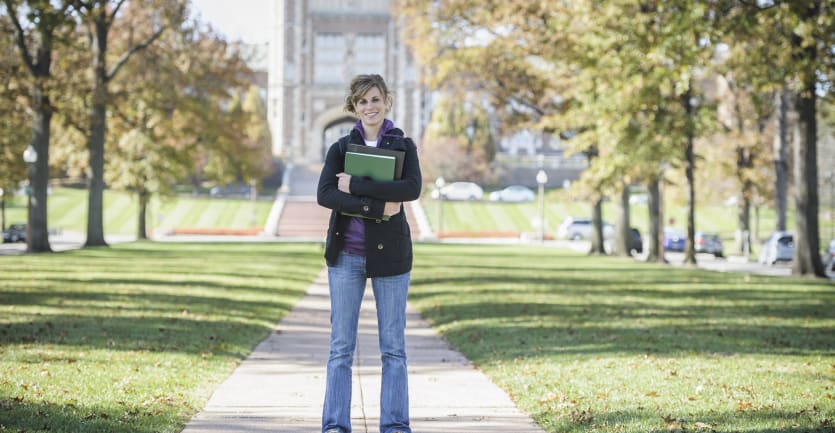What Options Will College Students Have This Fall?
- Many colleges plan to reopen their campuses this fall, but students question safety.
- Students can choose to re-enroll, switch to part time, or apply for a leave of absence.
- Potential scenarios for fall include more hybrid and low-residency options for students.
The list of colleges planning to reopen this fall continues to grow. While some schools have already announced plans to keep courses online, others are still waiting to decide.
At the same time, many students are debating whether to enroll. Ultimately, your decision should be based on not only your college’s plan for the fall but also more personal factors, such as whether you’ve experienced any changes in your financial situation due to the COVID-19 pandemic.
Rising unemployment and the significant cost of a college education can make it difficult to choose an appropriate course of action. Campus-based students may also be uncomfortable with the current state of remote learning and therefore hesitant to enroll in online courses for the rest of the year.
Before you make any decisions about the fall term, take some time to consider the following factors.

Enrollment Options for Students in Fall 2020
Study Part Time
Going to college full time may not be practical for you this fall, whether it’s due to financial considerations or the complicated logistics of being able to safely practice social distancing while traveling to and from campus. Shifting to a part-time school commitment could allow you to devote more time to your employment goals or other responsibilities.
One major downside is that attending college part time will likely extend your time to graduation. Additionally, not all financial assistance programs and scholarships cover part-time students, and international students may be unable to enroll with part-time status.
Take a Gap Year
For students currently graduating from high school, taking a gap year before entering college may be an attractive option. The uncertainty of the fall semester has led to an increase in the number of students exploring gap-year possibilities.
Traditionally, a gap year entails working, completing an internship, participating in a community service project, and/or traveling. Unfortunately, these activities may be limited due to the pandemic. Taking a gap year also requires a certain level of financial stability that many people don’t have right now due to the recent economic downturn.
Those interested in taking a gap year should start planning for it right away. If you’ve already accepted a college admission offer, you’ll need to start coordinating your plans with that school as soon as possible.
You should also think about what you’ll actually do during your year off. Structure is key. Finding a job or participating in a formal program that coordinates the gap-year experience can help you set goals for yourself and spend your time wisely.
Request a Leave of Absence
For students already enrolled in college, taking a leave of absence — i.e., a temporary break from school with the intent to later re-enroll — may be possible.
For example, maybe you’re unsure about the financial obligation of the fall term, or maybe you don’t want to continue taking online classes. In these cases, you can simply apply to take a semester off, allowing you to resume your courses in 2021.
Taking a leave of absence is a formal process, and every college maintains its own policies and procedures you’ll need to follow. Some schools — in anticipation of a surge in leave-of-absence requests due to COVID-19 — offer instructions for pursuing the process online. Check with your academic advisor, financial aid office, or registrar for details.
Proceed as Planned
Not every student wants or needs to consider alternatives for the upcoming fall semester. If you’re on track with your program, willing to engage in future courses and activities provided by your school, and able to financially commit to enrollment, you may consider sticking with your schedule and your school’s plans so you can continue making progress toward your degree.

Worries About Online Classes and Transfer Credits
Since colleges began closing their campuses and moving to remote classes, there has been concern about transfer credits. Will students be allowed to transfer credits received from online summer or fall classes? This anxiety is particularly relevant for students who are applying to graduate school or planning to transfer from a two-year college to a four-year institution.
Accreditation Remains Key for Transfer Credits
In most cases, schools use official transcripts to evaluate transfer credits. Fortunately, accreditation of the school or program where the student earned the credits is by far the biggest factor in determining whether they will transfer — not whether they were earned online. The accreditation process for online and on-campus programs is equivalent and uses the same standards.
Online Classes May Present Issues for Graduate School
For graduate school applications, transferring prerequisite courses that were taken online can present some challenges. For example, many medical schools don’t accept online courses as prerequisites. It’s a similar deal for classes taken pass/fail.
Because so many colleges moved to online learning and pass/fail grading options for the spring semester, new guidelines have emerged. Some schools understand that these changes are out of students’ control and are thus making temporary adjustments to their admission requirements.
You can contact the graduate programs you’re interested in for more information about their admissions process and class requirements.
Transferring from Two-Year to Four-Year Schools
Transferring from one college to another is not uncommon. A 2015 report found that 37% of all college students transfer at least once, and almost half of those transferring do so more than once.
Many college students begin at a two-year school with the intent to transfer to a four-year institution after completing some coursework. These courses might include general education classes or even culminate in an associate degree (before the student transfers to a four-year college to earn their bachelor’s degree).
Beginning at a two-year community college or technical school is often viewed as a stepping stone to a bachelor’s degree, and this remains true despite the massive shift to online learning. These schools typically offer more opportunities to earn credits online, on campus, or through a combination of class formats; they also often entail lower costs and smaller class sizes. As such, you may have to adjust your expectations for your college experience.

Students Can Consider New Study Opportunities
Changes to the college experience as a result of COVID-19 could present opportunities you hadn’t considered before.
The pandemic’s impact on specific industries, individual businesses, the job market, and the overall economy may have you rethinking your major and career goals. While it’s still too soon to know what the long-term implications of the coronavirus outbreak might be, it’s never too early to explore your options.
Work with your advisor to learn more about adding a minor to your major, completing a certificate program along with your major, adding a second major, or even completing two separate degrees.
All of these options require a significant addition to your workload — and potentially your financial commitment — but could effectively prepare you for a future that’s less certain than ever.
Think Beyond “Online” and “On Campus”
Inside Higher Education recently profiled 15 possible scenarios for the fall semester on traditional college campuses. “Back to normal” and “fully remote” made the list, but the remaining 13 scenarios offer a glimpse into the wide range of possibilities.
For example, the “low-residency” scenario includes brief, albeit intense, in-person sessions, with the majority of work completed at a distance. The “HyFlex” model proposes offering courses in both online and on-campus formats to give students a choice in how they can participate.
Online and remote learning may become part of the traditional college experience for a longer time than originally anticipated. Every school is making its own decisions, so be sure to stay up to date with your college through its website, student groups, and emergency contact channels.

Plan for Your Fall Experience
Even if your school elects to reopen its campus this fall, this decision could mean a variety of possible realities. Making the switch from campus-based to remote classes was quick, but the switch back to campus classes and services will likely take longer.
Talk to your academic advisor as well as the people you are closest with, such as your family, friends, mentors, supervisors, or coworkers. Weigh the pros and cons of your school’s decision for fall, develop a plan you’re comfortable with, and find a way to move forward.
As you develop your list of college options for fall, try not to overwhelm yourself — there is no single correct decision but in fact several good alternatives from which you can choose.